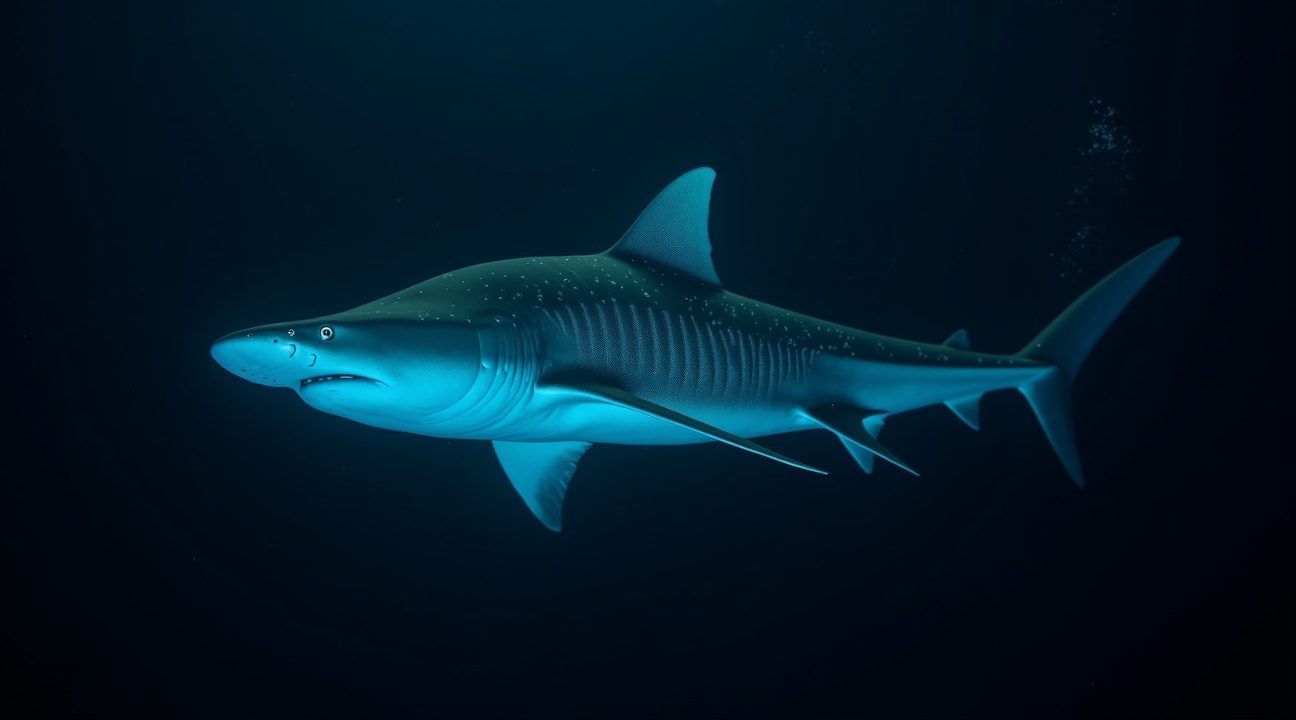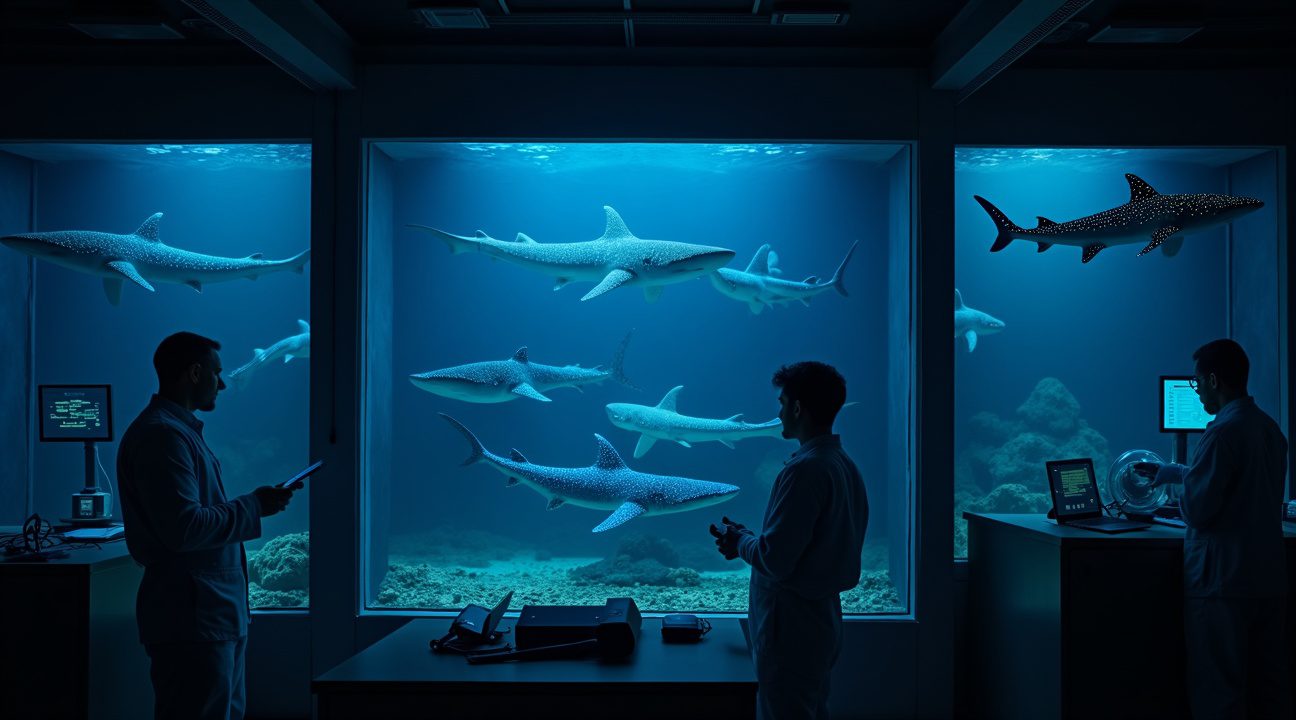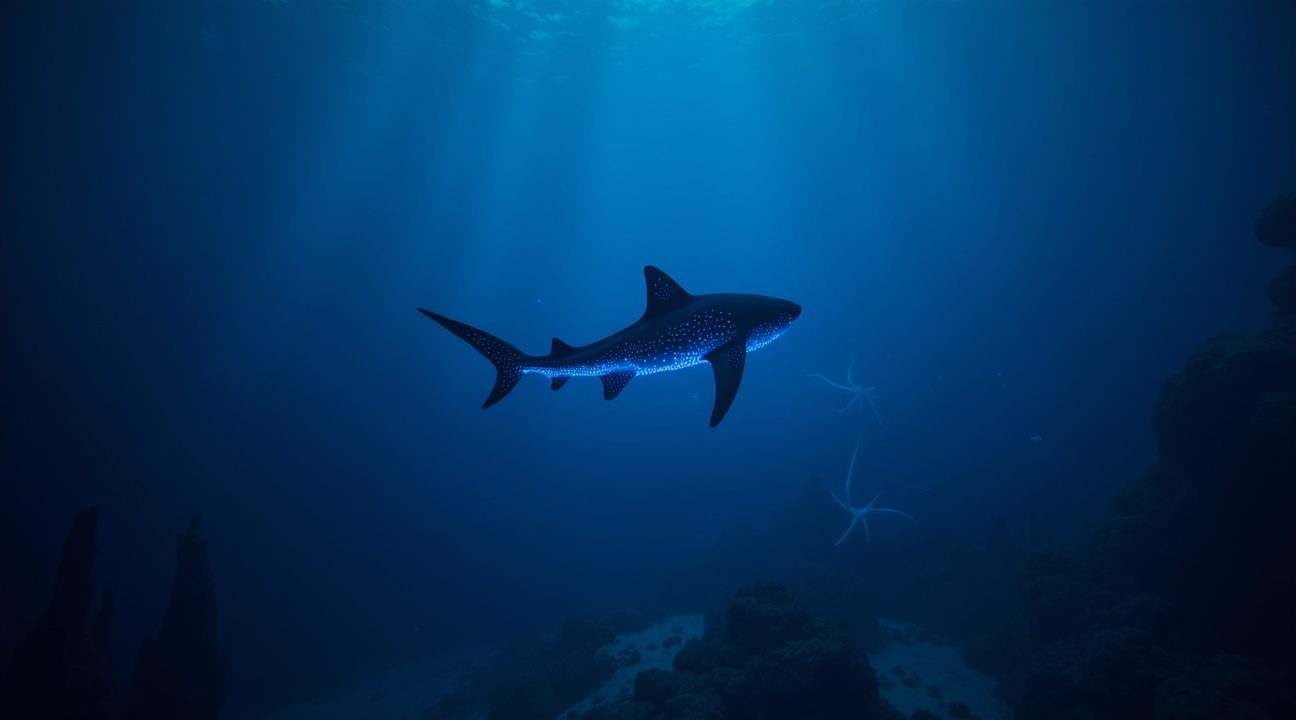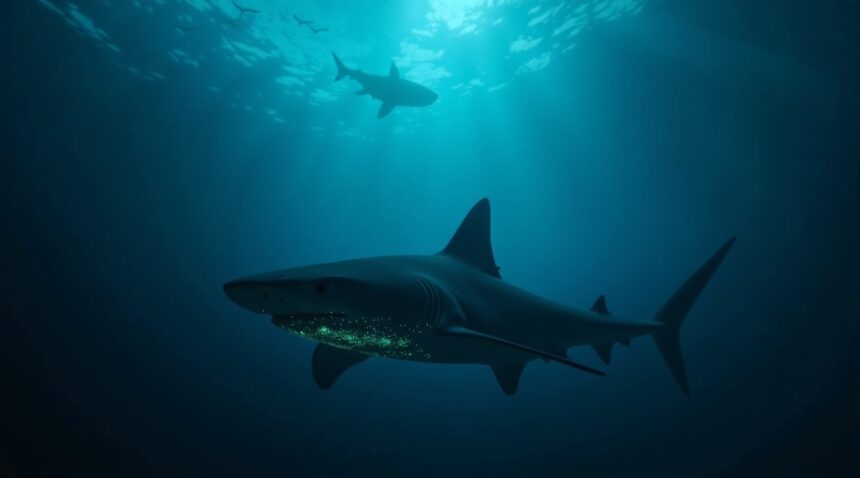Scientists have confirmed that the kitefin shark (Dalatias licha) holds the record as the planet’s largest bioluminescent vertebrate, reaching lengths up to 1.8 meters and illuminating through specialized light-emitting structures called photophores.
This extraordinary discovery, made off the coast of New Zealand in 2020, demonstrates the shark’s ability to emit light using a complex system of photocytes. This capability plays a crucial role in survival strategies such as camouflage, communication, and hunting in the ocean’s twilight zone.
Key Takeaways
- The kitefin shark emits blue-green light through photophores, with concentration on its ventral surfaces and dorsal fins, enabling counter-illumination camouflage.
- Live specimens were studied after being captured in January 2020 near New Zealand’s Chatham Rise, where researchers could examine natural bioluminescence behaviors in controlled lab environments.
- Over 50 of the 540 known shark species demonstrate bioluminescent traits, which are regulated by melatonin instead of relying on bacterial symbiosis like many other marine organisms.
- The kitefin shark utilizes its bioluminescence for invisibility from predators, luring prey, and deep-sea communication with other sharks.
- This discovery alters current perspectives on ecological dynamics in the deep sea, implying that bioluminescence among large vertebrates may be more prevalent than previously understood.
Further Reading
You can explore the details of the study in the Scientific Reports journal, where researchers discuss the significance of bioluminescence in deep-sea marine life and its broader ecological implications.
Massive Glowing Shark Breaks Records as World’s Largest Light-Producing Vertebrate
The kitefin shark (Dalatias licha) has officially claimed the title of world’s largest bioluminescent vertebrate, marking a significant discovery in marine biology. These remarkable predators can reach lengths of up to 1.8 meters (5 ft 11 in), dramatically surpassing previous record holders in the glowing vertebrate category.
Scientists first documented this extraordinary phenomenon off the coast of New Zealand, particularly around the Chatham Rise region. This underwater mountain range extends eastward from New Zealand’s South Island and has become a hotspot for studying deep-sea bioluminescence. The discovery adds another fascinating chapter to our understanding of how marine life adapts to extreme depths, much like the deepest fish species found in ocean trenches.
The Science Behind the Glow
The kitefin shark’s impressive light display results from specialized cellular structures called photophores. These unique organs contain photocytes—cells specifically designed to produce and emit light through biochemical reactions. The process creates a distinctive blue-green illumination with wavelengths ranging from 455 to 486 nanometers, perfectly suited for deep-ocean communication and hunting strategies.
I find the distribution pattern of this bioluminescence particularly fascinating. The light primarily concentrates along the shark’s ventral surface and dorsal fins, creating a strategic lighting arrangement that likely serves multiple purposes:
- Counter-illumination camouflage against predators looking up from below
- Enhanced hunting capabilities in the pitch-black deep-sea environment
- Potential communication signals with other kitefin sharks
- Confusion tactics when encountering prey or threats
Weaker light emissions appear along the sides and back of the shark, suggesting a carefully evolved lighting system that maximizes survival advantages while minimizing energy expenditure. This sophisticated biological lighting rivals some of the most impressive displays found in other marine creatures, including the massive specimens that occasionally surface, like the giant squid that capture public imagination.
The Chatham Rise location proves ideal for studying these phenomena due to its unique oceanographic conditions. The area’s deep waters and diverse ecosystem provide perfect habitat conditions for various bioluminescent species. The region’s position creates upwelling currents that bring nutrient-rich waters to the surface, supporting complex food webs that extend into the deep-sea zones where kitefin sharks thrive.
Research teams used specialized underwater cameras and light-sensitive equipment to capture and analyze the sharks’ bioluminescent displays. The consistent blue-green wavelength spectrum suggests highly evolved photophore systems that have adapted specifically for deep-ocean conditions. Blue-green light travels furthest through seawater, making it the most efficient choice for underwater communication and visibility.
The kitefin shark’s record-breaking size combined with its light-producing abilities represents a significant evolutionary achievement. Previous bioluminescent vertebrate champions were considerably smaller, typically measuring less than a meter in length. This discovery reshapes our understanding of how large marine animals utilize bioluminescence in their daily survival strategies.
Scientists continue investigating whether the intensity and patterns of light emission vary based on the shark’s age, size, or environmental conditions. Preliminary observations suggest that larger specimens produce more intense illumination, possibly indicating that bioluminescence plays increasingly important roles as these sharks mature and take on apex predator responsibilities in their deep-sea ecosystems.
The research also contributes to broader studies of marine biodiversity in New Zealand waters, which continue to reveal remarkable species adaptations. These waters have become increasingly important for marine conservation efforts, particularly as scientists document the return of large marine mammals to various Pacific regions.
Understanding the kitefin shark’s bioluminescent capabilities provides valuable insights into deep-sea ecology and evolution. The discovery emphasizes how much remains unknown about our ocean’s deepest inhabitants and their extraordinary adaptations to life in perpetual darkness.

Scientists Document First Live Glowing Kitefin Sharks in Breakthrough Study
A groundbreaking scientific expedition to the Chatham Rise off New Zealand in January 2020 marked a pivotal moment in marine biology research. Scientists collected the first live specimens of kitefin sharks specifically for bioluminescence investigation, setting the stage for unprecedented discoveries about these mysterious deep-sea creatures.
Laboratory Documentation of Living Specimens
Researchers placed the captured sharks in seawater tanks under complete darkness to observe their natural light emission patterns. This experimental approach allowed scientists to document glowing patterns across multiple body regions of the living sharks for the first time. The controlled laboratory environment provided clear evidence of bioluminescence that had previously only been theorized or observed in deceased specimens.
The methodology proved revolutionary because it captured the sharks’ natural bioluminescent behavior without the stress or damage that occurs during traditional collection methods. Scientists could observe how the light patterns varied across different parts of the shark’s body and how the intensity changed under various conditions.
Comparative Analysis Reveals Evolutionary Patterns
The landmark February 2021 study published in Frontiers in Marine Science expanded beyond kitefin sharks to include other bioluminescent species collected during the same expedition. Researchers compared the kitefin sharks with the blackbelly lanternshark (Etmopterus lucifer) and the southern lanternshark (Etmopterus granulosus), revealing fascinating similarities in their light-producing capabilities.
This comparative analysis demonstrated evolutionary conservation of bioluminescence across related deep-sea shark families, particularly the Dalatiidae and Etmopteridae. The findings suggest that bioluminescence evolved as a crucial adaptation for survival in the deep ocean environment, where sunlight never penetrates. These discoveries complement other remarkable deep-sea findings, including the deepest fish ever found at extreme ocean depths.
The study established that bioluminescence isn’t merely a random trait but represents a sophisticated evolutionary strategy shared across multiple shark lineages. Scientists documented consistent patterns in how these sharks use their bioluminescent capabilities, suggesting similar ecological pressures shaped their development across different species. This research joins other extraordinary marine discoveries, such as giant squid footage and blue whale populations, expanding our understanding of ocean biodiversity.

How These Deep-Sea Predators Use Their Glow to Survive in the Ocean’s Twilight Zone
Kitefin sharks inhabit one of Earth’s most challenging environments – the ocean’s twilight zone, stretching from 200 to 600 meters below the surface. In this mysterious layer of water, sunlight barely penetrates, creating a perpetual dusk where survival depends on specialized adaptations.
Counter-Illumination: The Art of Underwater Invisibility
The kitefin shark’s most remarkable survival strategy involves counter-illumination, a sophisticated form of camouflage that transforms these predators into virtual ghosts. The shark’s belly emits blue light that precisely matches the color and intensity of the faint sunlight filtering down from above. When potential predators look up from the depths below, they see only what appears to be natural background light rather than a shark silhouette.
This biological cloaking device requires incredible precision. The shark must constantly adjust its light output to match changing conditions as it moves through different depths and times of day. Unlike simple surface camouflage that relies on static patterns, counter-illumination demands real-time adaptation to the environment’s lighting conditions.
Multiple Functions Beyond Camouflage
Bioluminescence serves kitefin sharks in several critical ways beyond hiding from predators. Communication represents another vital function, allowing these solitary hunters to signal their presence to potential mates across the vast darkness. Different light patterns and intensities likely convey specific messages about reproductive status, territorial boundaries, or species identification.
Prey attraction adds another dimension to their glowing capabilities. The sharks can manipulate their bioluminescent displays to mimic smaller organisms that their target prey typically feeds on. This biological lure draws unsuspecting victims within striking distance, giving the shark a significant hunting advantage in an environment where food sources are scarce.
Blue light emission proves particularly effective in deep-sea environments because blue wavelengths travel farther through water than other colors. Deep-sea creatures have evolved to maximize the efficiency of their bioluminescent communications by utilizing this optimal wavelength.
I find it fascinating how these ecological adaptations demonstrate the incredible ingenuity of evolution in extreme environments. The twilight zone presents unique challenges that have shaped entirely different survival strategies compared to surface waters. Where sunlight-dependent creatures rely on photosynthesis and visual hunting, deep-sea predators like kitefin sharks have developed biological light sources that serve multiple survival functions simultaneously.
The sharks’ ability to control their bioluminescence also suggests a level of neurological sophistication that researchers are still working to understand. The precise timing and intensity control required for effective counter-illumination indicates complex feedback systems between the shark’s photoreceptors and light-producing organs.
Competition for resources in the twilight zone is intense, making every adaptation crucial for survival. Giant squid and other large predators also inhabit these depths, creating a dynamic ecosystem where bioluminescence becomes a fundamental tool for both hunting and avoiding becoming prey.
The kitefin shark’s glowing abilities represent millions of years of evolutionary refinement. Each photophore (light-producing organ) functions like a miniature spotlight that the shark can control independently. This level of control allows for complex light displays that can serve different purposes depending on the situation – whether escaping danger, attracting prey, or communicating with other sharks.
Understanding these deep-sea adaptations provides valuable insights into how life thrives in extreme conditions. The ocean’s twilight zone remains one of the least explored environments on Earth, yet discoveries like the kitefin shark’s bioluminescent capabilities reveal the remarkable diversity of survival strategies that exist in our planet’s deepest waters. Marine life continues to surprise scientists with innovative solutions to environmental challenges that seemed impossible to overcome.

The Science Behind Shark Bioluminescence Reveals Unique Light-Producing Mechanism
Understanding the fundamental difference between bioluminescence and biofluorescence proves crucial when examining these remarkable sharks. Bioluminescence refers to light produced internally through a chemical reaction, distinguishing it from biofluorescence, which is light that is absorbed and re-emitted. While whale sharks exhibit biofluorescence, they don’t produce their own light biochemically, unlike the bioluminescent kitefin shark.
Photophores and Melatonin Control Systems
In kitefin sharks, photophores serve as the specialized structures responsible for light emission. These microscopic organs contain light-producing cells that generate illumination through complex biochemical processes. Their activation is controlled by the hormone melatonin—a unique trait among vertebrates that sets these sharks apart from other glowing marine life.
Research has shown through histological analysis that the photophores vary in organization, morphology, and density across different regions of the shark. Scientists discovered that these light-producing organs cluster more densely on the shark’s ventral surface, creating patterns that help with camouflage and communication in the deep ocean environment.
Distribution Across Shark Species
The prevalence of bioluminescence among sharks extends far beyond the record-breaking kitefin shark. More than 50 of the 540 known shark species are either suspected or confirmed to exhibit bioluminescence. This remarkable adaptation allows them to thrive in the ocean’s deepest environments, where sunlight can’t penetrate.
Many of these species reside below 200 meters in depth, particularly in the twilight zone where ambient light begins to fade. This depth range provides the perfect environment for bioluminescent communication and hunting strategies. Deep-sea sharks use their light-producing capabilities for counter-illumination, matching the faint light filtering down from above to avoid detection by predators and prey.
The melatonin-controlled system represents an evolutionary breakthrough that distinguishes shark bioluminescence from other marine organisms. Unlike the bacterial symbiosis found in many glowing fish species, sharks produce light through their own cellular machinery. This independence gives them precise control over when and how brightly they illuminate, making them formidable hunters in the ocean’s darkest depths where marine giants and mysterious creatures share the same habitat.
Discovery Reshapes Understanding of Deep Ocean Life and Ecosystem Dynamics
The identification of the kitefin shark as the largest bioluminescent vertebrate represents a significant breakthrough that challenges established scientific understanding of deep ocean environments. This discovery forces researchers to reconsider fundamental assumptions about how life operates in the planet’s most mysterious habitat.
Scientists now recognize that bioluminescence extends far beyond the small organisms traditionally associated with this phenomenon. The kitefin shark’s remarkable ability to produce light demonstrates that even large predators have evolved sophisticated mechanisms to thrive in complete darkness. This finding suggests that bioluminescent adaptations may be far more common among marine vertebrates than previously understood.
Complex Mechanisms Drive Evolutionary Success
The complex mechanisms underlying bioluminescence in large vertebrates reveal extraordinary evolutionary adaptations. I find it fascinating how these organisms have developed specialized photophore cells that can generate light through biochemical reactions. This adaptation serves multiple purposes, from communication and camouflage to hunting strategies that maximize survival in nutrient-scarce environments.
Research expeditions continue to uncover the intricate ways these adaptations function. Scientists observe that the kitefin shark’s bioluminescence likely evolved as a response to specific environmental pressures found at depths where sunlight cannot penetrate. This evolutionary pathway demonstrates how organisms can develop entirely new capabilities to exploit available ecological niches.
The biomechanical traits associated with bioluminescence extend beyond simple light production. These adaptations influence swimming patterns, energy conservation, and metabolic processes that allow large vertebrates to maintain their luminescent capabilities while surviving in extreme conditions. Understanding these connections helps researchers appreciate the sophisticated nature of deep-sea evolution.
The widespread presence of bioluminescent species throughout ocean depths indicates that this adaptation plays a crucial role in marine ecosystem dynamics. Traditional models of predator-prey relationships require substantial revision when considering how light production affects hunting success, territorial behavior, and species interactions. The discovery of deepest fish species continues to reveal new aspects of these complex relationships.
Biodiversity distribution patterns in oceanic ecosystems show clear connections to bioluminescent capabilities. Species that can produce light often occupy different ecological positions compared to non-luminescent organisms. This separation creates distinct community structures that influence everything from food web dynamics to reproductive strategies.
The oceanic environment represents Earth’s largest habitat, containing an estimated 99% of the planet’s living space. Within this vast ecosystem, bioluminescence serves as a primary communication method, replacing visual cues that depend on external light sources. The kitefin shark’s discovery highlights how this communication system operates among large vertebrates, suggesting that similar adaptations may exist in other species yet to be documented.
Recent research expeditions have revealed that bioluminescent organisms create complex signaling networks throughout the water column. These networks facilitate species recognition, mating behaviors, and territorial establishment in ways that researchers are only beginning to understand. The discovery of giant squid footage provides additional evidence of how large marine organisms use light-based communication systems.
Predator-prey dynamics in deep ocean environments operate according to principles that differ significantly from surface ecosystems. Bioluminescent predators like the kitefin shark can use their light-producing abilities to disorient prey, create false targets, or coordinate group hunting behaviors. Conversely, prey species have evolved counter-adaptations that allow them to detect and avoid bioluminescent threats.
The energy requirements for maintaining bioluminescent capabilities represent another critical factor in ecosystem dynamics. Large vertebrates must balance the metabolic costs of light production with the survival benefits it provides. This balance influences population distributions, migration patterns, and reproductive success rates throughout marine environments.
Continued research into bioluminescence promises to reveal additional connections between light production and ecosystem function. Scientists expect that future discoveries will demonstrate even more sophisticated uses of bioluminescence among marine vertebrates. The recent documentation of blue whale returns to various ocean regions may also reveal new insights into how large marine animals interact with bioluminescent ecosystems.
These findings underscore the importance of protecting deep ocean habitats where such remarkable adaptations continue to evolve. Conservation efforts must account for the unique requirements of bioluminescent species and the ecosystem services they provide in maintaining marine biodiversity.
https://www.youtube.com/watch?v=UOj3kGbD9uU
Future Research Could Unlock Secrets of Ocean’s Most Mysterious Habitat
Scientists are preparing to launch comparative research initiatives that will examine bioluminescent characteristics across different shark families and species. These comprehensive studies will help researchers understand how light-producing abilities developed and spread throughout various lineages of these ancient predators.
Comparative Analysis Reveals Evolutionary Patterns
The upcoming research will focus on several key areas that could revolutionize our understanding of marine life:
- Communication systems between sharks using bioluminescent signals
- Navigation techniques in complete darkness using internal light sources
- Predation strategies enhanced by controlled light emission
- Mating behaviors that incorporate luminescent displays
- Territorial marking through species-specific light patterns
These investigations will examine the adaptive significance of bioluminescence, particularly how these traits provide survival advantages in the ocean’s most challenging environments. Researchers expect to discover whether different shark species developed similar light-producing mechanisms independently or inherited them from common ancestors.
Direct observation in deep-sea environments continues to present significant obstacles for marine biologists. The extreme pressure, complete darkness, and remote locations make it nearly impossible to study these creatures in their natural habitat without sophisticated technology. Current research relies heavily on specimens brought to the surface, which often don’t survive the dramatic pressure changes.
Despite these challenges, scientists are making remarkable progress in understanding how deep-sea creatures have adapted to life in Earth’s most extreme environments. The prevalence of light-producing mechanisms among marine organisms continues to surprise researchers, with new discoveries happening regularly.
Recent technological advances in deep-sea exploration equipment are opening new possibilities for direct behavioral studies. Submersibles equipped with specialized cameras and sensors can now capture footage of bioluminescent sharks in action, similar to how researchers have documented giant squid behavior in recent years.
https://www.youtube.com/watch?v=_kY8kQ-T0rA
These studies will contribute to broader understanding of ecosystem function in the deep ocean. Scientists believe that bioluminescence plays a crucial role in maintaining the delicate balance of marine food webs, particularly in environments where traditional visual cues don’t exist.
The research will also investigate how climate change and human activities might affect bioluminescent species. As ocean temperatures rise and pollution increases, these ancient adaptations could face new pressures that threaten their effectiveness.
Future discoveries may reveal connections between bioluminescent sharks and other marine species, including the large whale populations that share their habitat. Understanding these relationships will help scientists protect these critical ecosystems for future generations.
Sources:
Oceanic Worldwide, “Bioluminescent Shark Found Off New Zealand Coast”
Indian Defence Review, “World’s Largest Glow-In-The-Dark Shark”
Times of India, “Meet the world’s largest bioluminescent predator discovered underwater”
Guinness World Records, “Largest bioluminescent vertebrate”
IFLScience, “The Largest Bioluminescent Vertebrate Known To Science Is A Shark”
Frontiers in Marine Science, “Bioluminescence of the Largest Luminous Vertebrate, the Kitefin Shark, Dalatias licha: First Insights and Comparative Aspects”

